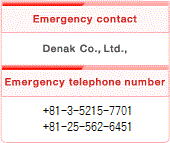Treatment: Monochloroacetic Acid
First aid
Provide the material safety data sheet of this product to the physician when receiving treatment at a hospital. (*Note 1 below.)
If the patient might have touched or ingested monochloroacetic acid or might have been exposed to its vapor, or if symptoms indicative of such events appear, be sure to have the patient seek medical care from a physician.
Since the effects of exposure can be delayed, medical follow-up is [always] necessary.
Note: Click here to download the data sheet ¨monochloroacetic acid (synonym: chloroacetic acid)PDF[327KB]
InhalationF
- Wrap a blanket around the patient, allow the patient to rest quietly, and move him/her to a place with fresh air.
- Promptly transport the patient to a hospital.
- If the patient has dyspnea or has stopped breathing, immediately begin artificial respiration or use a resuscitator.
Skin contactF
- If monochloroacetic acid comes into contact with the skin, it is most important to immediately immerse the skin in sodium bicarbonate solution or wash with large amounts of water.
- If an extensive area is affected, immerse in a bath of approximately 3-5% sodium bicarbonate solution (water temperature: 25-35) for a minimum of 4 hours, and seek medical care from a physician.
- Contaminated clothes should be removed promptly as the aforementioned treatment is performed.
Eye contactF
- Since MCA can injure the cornea and the eyelids, immediately wash the eyes for at least 15 minutes with large amounts of 0.9% saline solution or purified water. Be sure to seek medical care from an ophthalmologist.
- Washing of eyes can be achieved effectively by opening the eyelids with the thumb and index finger.
- If the patient is wearing contact lenses, unless they are adhered, take them off and wash the eyes.
IngestionF
- Rinse the mouth and have the patient drink water. (Do not induce vomiting.)
- Allow the patient to rest quietly and to breathe fresh air. Place the patient in a reclined position and transport the patient to the hospital.
Most important signs and symptomsF
Pain on the skin, burning pain, severe chemical injury, cold sweat, nausea, edema, dyspnea, blood pressure decline, coma, shock, pain and swelling of the eyes, and pain and tightness of the respiratory tract and lungs
Protection for people providing emergency measuresF
In rescuing the victim, wear acid-resistant clothes, long boots, and goggles or full face shield, latex or polyvinyl chloride gloves.



